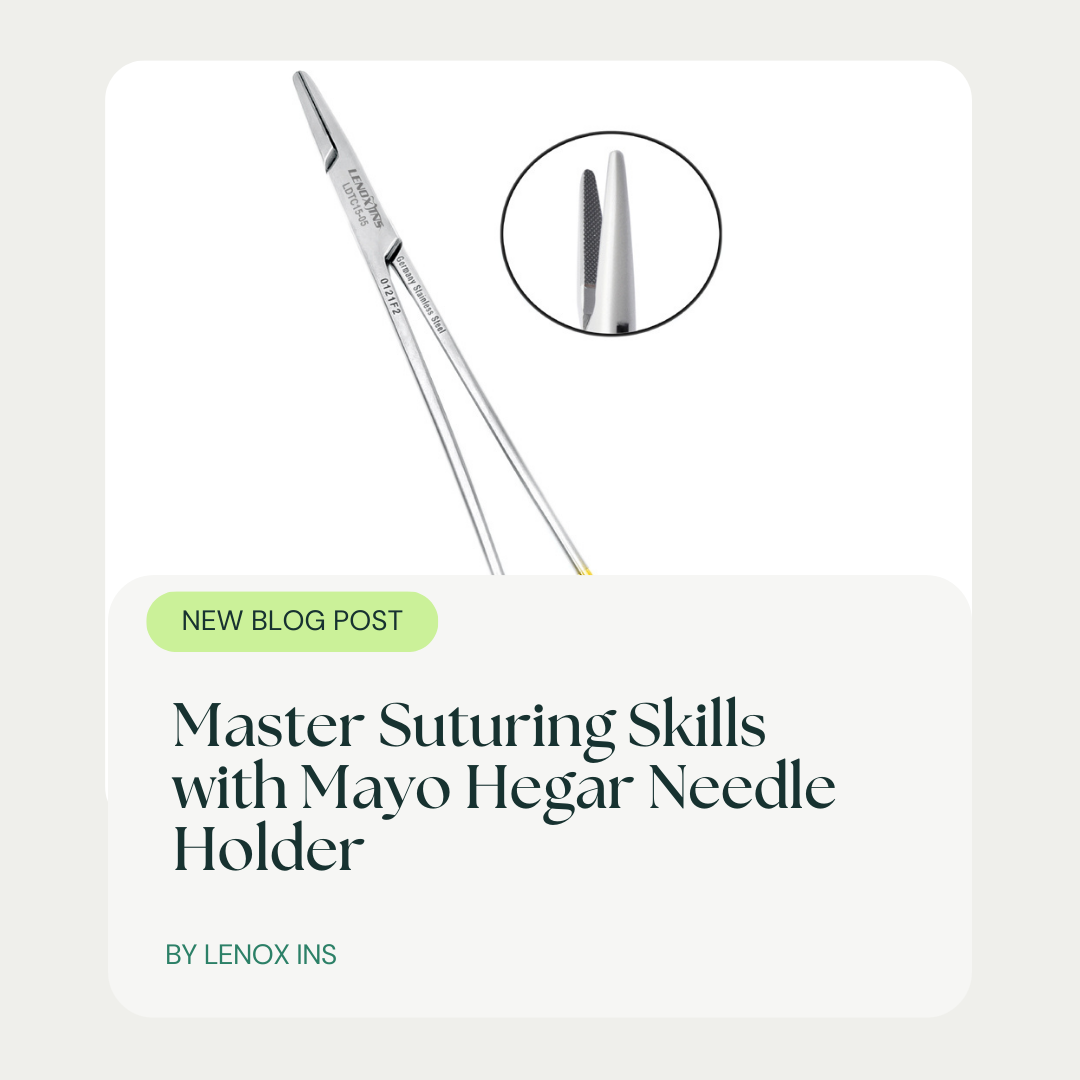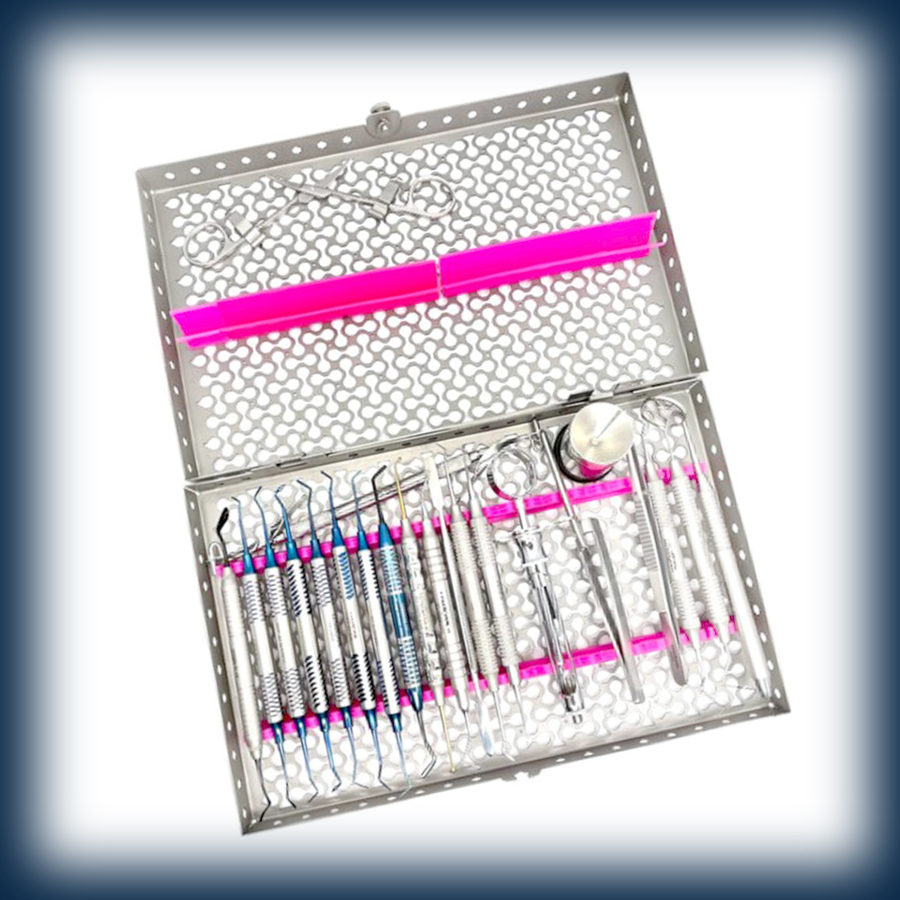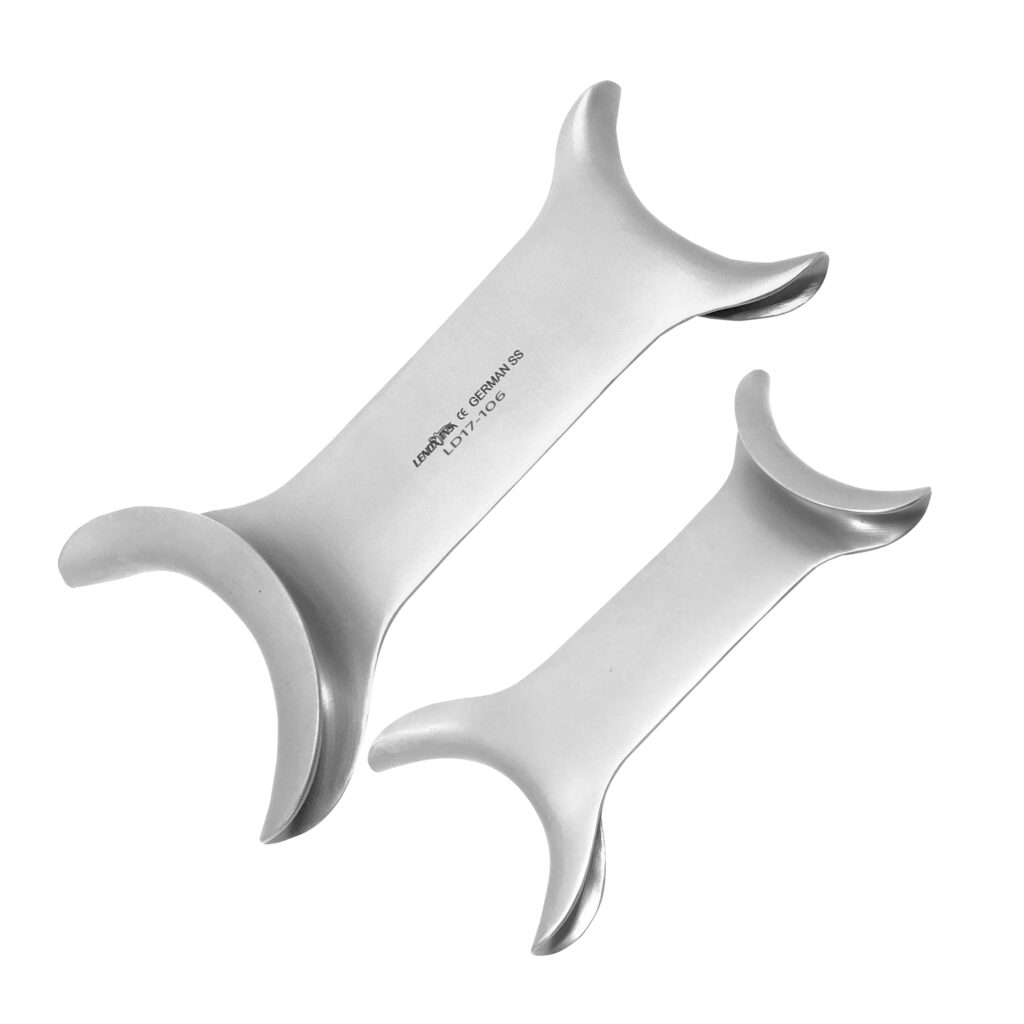Understanding Different Types of Dental Bone Rongeurs
- Posted October 28, 2024
- by lenoxinstro
Understanding the appropriate tools is essential for successful dental procedures. Dental bone rongeurs, often overlooked, are critical instruments for extracting and shaping bone. This guide will cover the various types of dental bone rongeurs, their applications in procedures, and tips for selecting the right instrument. By reading this content, readers will gain insights into maximizing the effectiveness of these steel hand tools while ensuring safety and proper maintenance. Whether performing extractions or preparing for implants, having the right knowledge can significantly enhance the success of treatments. Dental bone rongeurs
Key Takeaways
- Dental bone rongeurs are essential tools for precise bone removal in various dental procedures
- Ergonomic designs enhance user comfort and reduce strain during long surgical sessions
- Material choice, such as stainless steel or titanium, impacts durability and biocompatibility
- Proper cleaning and sterilization protocols ensure patient safety and instrument longevity
- Continuous education and training are vital for safe and efficient use of bone rongeurs
Overview of Dental Bone Rongeurs

Dental bone rongeurs are specialized instruments used primarily in surgical procedures to remove bone and tissue. Their historical development reflects advancements in dentistry, particularly in orthodontics and oral surgery. Key features of dental bone rongeurs include stainless steel construction, ergonomic designs for ease of use, and variations like spatula-shaped tips for precision. The following sections will delve into each of these aspects, highlighting the functionality, materials, and significance of these tools in dental practice. Dental bone rongeurs
Definition and Function of Bone Rongeurs
Dental bone rongeurs are surgical instruments designed specifically for the removal of bone and tissue during dental procedures, particularly in tooth extraction and dental extraction surgeries. Constructed from surgical stainless steel, these rongeurs provide durability and resistance to infection, ensuring safe handling in clinical environments. Their design allows for precise control, enabling dental professionals to effectively manage the removal of bone without compromising surrounding tissues, thus improving surgical outcomes and patient comfort.
Historical Development in Dentistry
The historical development of dental bone rongeurs has significantly shaped modern dental practices, particularly in fields like oral surgery and plastic surgery. Initially crafted from rudimentary materials, these instruments have evolved into specialized tools made from surgical-grade stainless steel that can withstand ultrasonic cleaning and provide optimal durability. As the demand for precision and increased functionality grew, variations in length and design emerged, allowing dental professionals to address complex surgical situations more effectively.
- Evolution of instrument materials from rudimentary to surgical-grade stainless steel.
- Increased focus on design variations for improved precision and functionality.
- Growing importance of ergonomic designs in enhancing user experience.
- Development of protocols for sterilization, including ultrasonic cleaning.
- Application in various fields, including oral surgery and plastic surgery.
Key Features of Dental Bone Rongeurs
Dental bone rongeurs incorporate several key features that enhance their efficacy during surgical procedures within the mouth and cheek areas. Their ergonomic design allows for comfortable handling, reducing strain on the dental professional during complex tasks such as sinus lift surgeries or neurosurgery-related procedures. Additionally, the precision tips on these instruments enable accurate bone removal, which is critical for achieving optimal surgical outcomes and minimizing trauma to surrounding tissues. Dental surgical rongeurs
Dental bone rongeurs come in various forms, each designed for specific procedures. Understanding these types reveals their unique roles and importance in dental practice. Micro Friedman bone rongeur La Grange bending 15cm
Different Types of Dental Bone Rongeurs

Different Types of Dental Bone Rongeurs
This section addresses the various types of dental bone rongeurs, essential for effective surgical procedures. It covers single-action versus double-action rongeurs, highlighting their operational differences, and examines side-cutting and end-cutting designs for specific applications. The discussion extends to angular rongeurs, available in 40° and 90° configurations, as well as specialized rongeurs tailored for unique procedures like bone grafting. Material considerations like stainless steel versus titanium will also be discussed, emphasizing their relevance in clinical settings, particularly concerning the handling of sutures and the protection of gums during surgery. dental rongeurs
Single-Action vs. Double-Action Rongeurs
Single-action rongeurs operate with a straightforward mechanism that requires one motion to complete the bone extraction process. This simplicity allows for precision when working around delicate tissue and is particularly useful in procedures that require careful maneuvering, like in regions where calipers are also utilized to gauge the diameter of bone segments. In contrast, double-action rongeurs employ a compound lever mechanism, providing enhanced force and control, making them ideal for heavier bone manipulation and extraction while minimizing the need for auxiliary tools such as elevators and scissors during surgery.
Side-Cutting and End-Cutting Rongeurs
Side-cutting and end-cutting rongeurs play crucial roles in dental surgeries, particularly in their ability to handle delicate tissues while effectively removing bone. Side-cutting rongeurs are engineered to cut through bone at an angle, allowing the surgeon to navigate around anatomical structures with precision, thereby minimizing trauma to the surrounding tissues. In contrast, end-cutting rongeurs utilize a straight-edged design, facilitating a direct and controlled approach for removing particulates of bone, cement, or other materials, which may be essential during complex procedures that involve the extraction of impacted teeth or preparation for screw placement. Rongeurs dental surgical
Angular Rongeurs: 40° and 90° Designs
Angular rongeurs, available in 40° and 90° designs, are essential surgical instruments tailored for specific dental procedures. These instruments allow dental professionals to maneuver effectively within constrained spaces, facilitating the precise removal of bone while minimizing trauma to adjacent tissues. For example, during complex tooth extractions that involve the removal of impacted teeth, the angled design helps navigate anatomical structures that may be obstructed by bone, ensuring a smoother procedure and better patient outcomes. Angular rongeurs
- Angular rongeurs aid in precision during dental surgeries.
- 40° and 90° designs facilitate effective bone removal.
- Essential for complex extractions and surgical maneuvers.
- Helps minimize trauma to surrounding tissues.
- Enhances surgical outcomes with careful maneuverability.
Specialized Rongeurs for Specific Procedures
Specialized rongeurs are essential for specific dental procedures, as they provide targeted functionality that addresses unique surgical challenges. For instance, rongeurs used in general surgery may be designed to effectively handle soft tissue while aiding in the precise removal of bone around a crown, ensuring minimal trauma during the procedure. These tools often incorporate features such as a built-in syringe for administering local anesthesia, enhancing overall efficiency and patient comfort in various surgical scenarios.
- Specialized rongeurs improve precision in specific dental surgeries.
- They address unique challenges presented in various procedures.
- Enhanced functionality supports effective management of soft tissue and bone.
- Incorporation of syringes streamlines anesthesia administration.
- Targeted design aids in reducing surgical trauma and improving outcomes.
Material Considerations: Stainless Steel vs. Titanium
When selecting dental bone rongeurs, the choice between stainless steel and titanium is pivotal, particularly in contexts such as orthopedic surgery where strength and durability are crucial. Stainless steel rongeurs are known for their resistance to corrosion, making them suitable for laboratory environments where sterilization is frequent. Conversely, titanium rongeurs are lighter and provide superior biocompatibility, which is essential during procedures involving lasers or drills to minimize patient reactions and promote faster healing.
- Stainless steel offers excellent corrosion resistance for frequent sterilization.
- Titanium is lighter and biocompatible, enhancing patient comfort.
- Material choice impacts durability and performance in surgical settings.
- Consideration of materials is essential for effective tool function.
With a solid grasp of the various types of dental bone rongeurs, it’s time to focus on their role in practice. Understanding how these tools are applied in dental procedures can shed light on their true value in effective treatments. Blumenthal bone rongeurs
Applications of Bone Rongeurs in Dental Procedures

Dental bone rongeurs play a crucial role in various dental procedures, including bone trimming and contouring, tooth extraction, and socket preparation. They are essential tools in implantology and grafting, and they also find application in pediatric dentistry and orthognathic surgery. This section delves into the practical use of rongeurs in managing jaw injuries, administering anesthesia, and supporting oral and maxillofacial surgery, providing valuable insights into their significance in enhancing patient outcomes.
Bone Trimming and Contouring
Bone trimming and contouring are critical applications of dental bone rongeurs, particularly in preparing a patient’s jaw for implants or crowns. These rongeurs allow dental professionals to shape and smooth bone edges effectively, ensuring proper fit and adhesion of dental work. Using a disinfectant regularly on these instruments also minimizes the risk of infection, while ergonomic designs help reduce fatigue during lengthy procedures.
- Trimming and contouring to prepare the jaw structure.
- Ensuring proper fit for implants and crowns.
- Using disinfectant to prevent infections.
- Reducing fatigue through ergonomic instrument design.
Tooth Extraction and Socket Preparation
Tooth extraction and socket preparation are critical procedures in dentistry, where dental bone rongeurs play a vital role. Following the use of a scalpel to access the extraction site, these instruments effectively remove bone and tissue surrounding the tooth, ensuring thorough socket preparation for future graft placements. The choice of rongeurs, particularly those that can withstand autoclave sterilization, contributes significantly to reducing the risk of disease transmission in clinical settings and supports the safe handling of materials used in graft manufacturing.
Use in Implantology and Grafting
In the context of implantology and grafting, dental bone rongeurs are essential for precise bone removal, allowing for effective placement of dental implants. These instruments facilitate the shaping of bone in preparation for veneers and ensure adequate space for graft materials, which may include amalgam. Additionally, rongeurs are often used alongside other tools, such as curettes and forceps, to ensure a comprehensive approach during the preparation and execution of procedures that enhance patient outcomes.
| Procedure | Function of Bone Rongeurs | Tools Used Alongside |
|---|---|---|
| Implant Placement | Shaping bone for implant stability | Curette, Forceps |
| Bone Grafting | Removing and contouring bone | Curette, Amalgam |
| Socket Preparation | Enabling proper healing and integration | Forceps, Curette |
Pediatric Dentistry Applications
Pediatric dentistry applications for dental bone rongeurs are essential to managing the unique challenges presented during children’s dental procedures. These rongeurs facilitate safe and effective surgery for procedures such as tooth extractions or restorative work in young patients. The use of specialized rongeurs, in conjunction with tools like retractors and tweezers, allows dental professionals to navigate the smaller structures of a child’s skull accurately, minimizing trauma and enhancing the overall experience for the patient and the dental team.
| Procedure | Function of Bone Rongeurs | Tools Used Alongside |
|---|---|---|
| Tooth Extraction | Removing bone around the tooth socket | Retractor, Tweezers |
| Restorative Work | Shaping bone for proper fitting | Retractor, Tweezers |
| Oral Surgery | Facilitating surgical access while preserving soft tissue | Tweezers, Forceps |
Orthognathic Surgery Support
In orthognathic surgery, dental bone rongeurs provide critical support by facilitating the precise removal of bone around the molars, which is essential for correcting jaw alignment. The use of a mallet in conjunction with these rongeurs can enhance the surgical approach, ensuring that bone contouring is performed with accuracy and minimal trauma. Maintaining strict hygiene standards during these procedures is vital, as contamination can result in complications; therefore, the choice of tools and materials, such as plaster for impression steps, plays a significant role in promoting patient safety and optimal outcomes.
Choosing the right dental bone rongeur is vital for success in each procedure. The right tool can make all the difference between a successful outcome and a challenging experience.
Selecting the Right Dental Bone Rongeur

Selecting the right dental bone rongeur involves a detailed assessment of procedure requirements, emphasizing the significance of ergonomics and handle design. Compatibility with other instruments, like pliers, is crucial to ensure seamless surgical workflows. Additionally, balancing quality and cost is essential for practical use, alongside recommendations from dental professionals that consider factors like corrosion resistance, sterilization, and material choice, such as titanium.
Assessing Procedure Requirements
When assessing procedure requirements for selecting a bone rongeur, dental professionals must consider the specific needs of each surgical task. Factors such as the size and location of the bone to be removed, desired precision, and the type of procedures being performed determine the appropriate choice of rongeur. Additionally, evaluating warranties and guarantees on instruments can provide assurance regarding durability and reliability, which are essential for maintaining high standards in dental practices.
Ergonomics and Handle Design
Ergonomics and handle design are critical factors in the selection of dental bone rongeurs, directly impacting the efficiency and comfort of dental procedures. Instruments with well-designed handles reduce hand fatigue, allowing dental professionals to perform intricate tasks for extended periods without strain. A thoughtful ergonomic design ensures that the rongeurs fit comfortably in the hand, facilitating precise control and minimizing the risk of mishaps during delicate procedures, such as socket preparation and bone contouring.
Compatibility With Other Instruments
Ensuring compatibility with other instruments is essential when selecting the right dental bone rongeur. This consideration facilitates a seamless surgical workflow, allowing dental professionals to effectively combine rongeurs with tools such as forceps, curettes, and retractors. By understanding how these instruments interact, practitioners can enhance their efficiency and precision during procedures, ultimately improving patient outcomes and minimizing the risk of complications.
Balancing Quality and Cost
Balancing quality and cost when selecting a dental bone rongeur is critical for dental professionals aiming to enhance their practice while managing expenses. Although high-quality instruments may come with a higher price tag, their durability and effectiveness can lead to long-term savings by reducing the need for frequent replacements. Additionally, investing in quality rongeurs that meet clinical standards can improve surgical outcomes and ultimately increase patient satisfaction, making it essential to weigh both factors carefully during the selection process.
| Consideration | Quality | Cost |
|---|---|---|
| Durability | Long-lasting, reduces frequent replacements | Higher upfront investment |
| Surgical Performance | Improves precision and outcomes | May lead to overall savings |
| Patient Experience | Increases satisfaction and trust | Can justify higher expenses |
Recommendations From Dental Professionals
Dental professionals recommend that practitioners prioritize ergonomics and handle design when selecting a dental bone rongeur. Instruments that provide a comfortable grip minimize hand fatigue during lengthy procedures, enhancing overall performance. It is also essential for dental practitioners to consider the instrument’s material, as stainless steel options offer durability, while titanium models enhance patient safety and comfort, making informed choices crucial for successful surgical outcomes.
Understanding how to choose the right dental bone rongeur lays the groundwork. Now, it is time to focus on the proper care and maintenance that will extend its life and effectiveness. Blumenthal bone rongeurs
Proper Care and Maintenance of Rongeurs

Proper care and maintenance of dental bone rongeurs are essential for ensuring their longevity and performance. This section will cover critical techniques such as effective cleaning after use, compliance with sterilization protocols, routine inspections for wear and damage, guidelines for sharpening and servicing, and best practices for storage. Together, these elements contribute to optimal functionality and safety in dental procedures.
Cleaning Techniques After Use
To ensure the longevity and effectiveness of dental bone rongeurs, effective cleaning techniques after use are essential. Immediately following a procedure, the instruments should be rinsed with warm water to remove any blood, bone, or tissue debris, preventing buildup that could compromise their function. Utilizing an ultrasonic cleaner can further enhance the cleaning process by effectively removing contaminants from hard-to-reach areas, thereby maintaining the rongeurs‘ precision and ensuring they remain safe for future surgical applications.
Sterilization Protocols
Sterilization protocols for dental bone rongeurs are critical for ensuring patient safety and instrument longevity. Following the completion of dental procedures, these instruments should undergo thorough cleaning to eliminate organic debris, followed by sterilization using autoclaves or chemical solutions that meet infection control standards. Adhering to these sterilization protocols not only prevents cross-contamination in clinical settings but also maintains the integrity and performance of the rongeurs, thereby supporting optimal surgical outcomes and enhancing patient care:
| Step | Description |
|---|---|
| Cleaning | Rinse with warm water to remove debris, followed by ultrasonic cleaning. |
| Sterilization | Use autoclaves or chemical sterilants according to established protocols. |
| Storage | Store in a clean, dry environment to prevent contamination. |
Inspecting for Wear and Damage
Regularly inspecting dental bone rongeurs for wear and damage is essential to maintaining their effectiveness and ensuring safe surgical practices. Dental professionals should examine the cutting edges and tips for signs of dullness or chipping, as well as check the hinges and handles for any signs of looseness or corrosion. Detecting these issues early can prevent complications during procedures and promote better patient care: dental rongeurs
- Assess cutting edges for dullness or damage.
- Check hinges and handles for looseness or corrosion.
- Perform inspections regularly after cleaning and sterilization.
- Ensure tools meet performance standards for effective use.
Sharpening and Servicing Guidelines
Regular sharpening and servicing of dental bone rongeurs are critical for maintaining their performance and ensuring the safety of surgical procedures. Dental professionals should prioritize using appropriate sharpening tools, such as specialized files or grinders, that are designed for the precise geometry of the rongeurs’ cutting edges, ensuring effective bone removal during surgeries. Routine servicing also includes lubrication of hinges to prevent wear and tear, which can significantly prolong the life of the instruments and enhance their reliability in clinical settings.
Storage Practices to Prolong Lifespan
Proper storage practices are essential for prolonging the lifespan of dental bone rongeurs. These instruments should be kept in a clean, dry environment, away from direct sunlight and moisture to prevent corrosion and degradation. Utilizing protective cases or trays can safeguard the cutting edges and tips from damage, while also maintaining their sterilized state between uses. Additionally, arranging rongeurs in designated areas minimizes the risk of accidental collisions with other instruments, thereby ensuring their reliability and effectiveness in clinical applications.
Proper care protects the tools that assist in surgery. Next, the reader will learn essential safety guidelines for using bone rongeurs to ensure both effectiveness and care in the operating room.
Safety Guidelines for Using Bone Rongeurs

Safety guidelines for using bone rongeurs are crucial for ensuring effective surgical practices and maximizing patient outcomes. This includes the necessity of proper training and skill development, along with considerations for patient comfort. Preventing instrument slippage is vital, as is adhering to dental regulations. Staying updated with best practices further enhances overall safety and efficiency in using these critical tools.
Training and Skill Development
Proper training and skill development are essential for dental professionals using bone rongeurs to ensure safe and effective surgical practices. Understanding the intricacies of various rongeur types and their specific applications allows practitioners to perform procedures with confidence and precision. Hands-on training combined with simulated practice scenarios can significantly enhance the ability to manage complex situations, ultimately improving patient outcomes and reducing surgery-related complications:
- Importance of understanding different rongeur types.
- Hands-on training and simulated practice enhance skills.
- Improved confidence leads to better patient outcomes.
- Reducing complications through demonstrated proficiency.
Patient Considerations and Comfort
In dental procedures involving bone rongeurs, ensuring patient comfort is paramount. Practitioners must closely monitor patient responses to various techniques, employing adequate anesthesia and sedation to minimize discomfort during surgery. Additionally, effective communication prior to the procedure can alleviate patient anxiety, as professionals explain the purpose and expectations of using dental bone rongeurs in their treatment, ultimately fostering a more positive surgical experience.
Preventing Instrument Slippage
Preventing instrument slippage during surgical procedures is vital for ensuring safety and precision when using dental bone rongeurs. Dental professionals can enhance their grip by utilizing rongeurs with textured handles or ergonomic designs that minimize hand fatigue, allowing for better control. Additionally, proper instrument positioning and firm, steady pressure during use can significantly reduce the risk of slips, ultimately leading to improved patient outcomes and enhanced surgical performance.
Compliance With Dental Regulations
Compliance with dental regulations is critical for ensuring that dental bone rongeurs are used safely and effectively in clinical settings. Dental professionals must adhere to the guidelines established by relevant health authorities, which often include updated standards for instrument sterilization, maintenance, and usage protocols. By regularly reviewing these regulations, practitioners can enhance patient safety and maintain high standards of care during surgical procedures involving bone rongeurs:
| Regulation Aspect | Importance |
|---|---|
| Sterilization Protocols | Prevents cross-contamination and infections. |
| Instrument Maintenance | Ensures tools remain functional and safe for use. |
| Usage Training | Improves proficiency and reduces the risk of surgical errors. |
Staying Updated With Best Practices
Staying updated with best practices is vital for dental professionals who utilize bone rongeurs during surgical procedures. Regular participation in continuing education courses and workshops, along with reviewing the latest research, ensures practitioners are aware of new techniques, materials, and safety protocols. Engaging with professional organizations and forums can provide valuable insights and necessary updates on effective handling, maintenance, and innovative uses of rongeurs:
- Promote continuous education through workshops and courses.
- Review the latest research on surgical techniques and safety protocols.
- Engage with professional organizations for insights and updates.
Conclusion
Understanding the various types of dental bone rongeurs is essential for dental professionals aiming to enhance surgical precision and patient outcomes. By recognizing the unique functions and design features of these instruments, practitioners can select the most suitable tools for specific procedures. Proper care, maintenance, and adherence to safety guidelines further ensure the effectiveness and longevity of rongeurs. Ultimately, a comprehensive knowledge of dental bone rongeurs significantly contributes to improved surgical practices and overall patient safety.

























